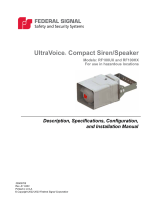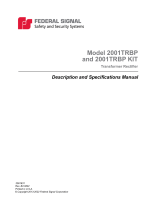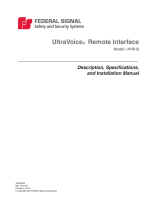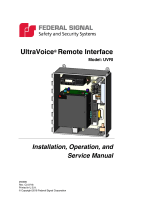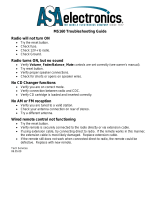Page is loading ...

25500444
Rev. C2 0423
Printed in U.S.A.
© Copyright 2018-2023 Federal Signal Corporation
UltraVoice®
Remote Interface
Indoor Controller
Model: UVRI-B Series C
Description, Specications, Installation,
Operation, and Conguration Manual

All product names or trademarks are properties of their respective owners.
Limited Warranty
This product is subject to and covered by a limited warranty,
a copy of which can be found at www.fedsig.com/SSG-Warranty.
A copy of this limited warranty can also be obtained by written
request to Federal Signal Corporation, 2645 Federal Signal Drive,
University Park, IL 60484, email to [email protected] or
call +1 708-534-3400.
This limited warranty is in lieu of all other warranties, express or
implied, contractual or statutory, including, but not limited to the
warranty of merchantability, warranty of tness for a particular
purpose and any warranty against failure of its essential purpose.
2645 Federal Signal Drive
University Park, Illinois 60484
www.fedsig.com
Customer Support 800-548-7229 • +1 708 534-3400
Technical Support 800-524-3021 • +1 708 534-3400

3
Description, Specications, Installation, Operation, and Conguration Manual
Federal Signal www.fedsig.com
Contents
Safety Messages......................................................................................................................................................8
General Description .............................................................................................................................................. 11
Overview ........................................................................................................................................................... 11
Features ............................................................................................................................................................ 11
Ordering Information ................................................................................................................................. 12
Specications ........................................................................................................................................................13
Installation ..............................................................................................................................................................16
Control Unit Location ........................................................................................................................................17
General Mounting Guidelines ...........................................................................................................................23
UVRI-B Installation Material List and Installation Guidelines ............................................................................24
Concrete or Filled Cement Block Wall Mounting Guidelines ....................................................................24
Hollow Block Wall Mounting Guidelines ....................................................................................................24
Wood Stud Wall Mounting Guidelines .......................................................................................................25
Metal Stud Wall Mounting Guidelines .......................................................................................................25
Electrical Connections ......................................................................................................................................27
Grounding Requirements ..........................................................................................................................27
Wiring Guidelines for 120 Vac Electrical Service .....................................................................................27
Wiring Guidelines for 240 Vac Electrical Service .....................................................................................28
Connecting Audio Output .......................................................................................................................... 28
Relay Output .............................................................................................................................................28
Ethernet Connection .................................................................................................................................28
Battery Connections ..................................................................................................................................29
Speaker Connections (JP2 on the Amplier board) ..........................................................................................29
Local PA Audio Connections (J1 on the UVRI-B Control board) ....................................................................... 29
Remote Activation Contact Closure Inputs (JP22 on the UVRI-B Control board) .............................................29
Optional Powering of the UVRI-B with 24 Vdc (JP23 on the UVRI-B Control board) .......................................30
600 ohm I/O Connections (JP8 on the UVRI-B Control board) .........................................................................30
Control Connections .................................................................................................................................30
Audio Connections ....................................................................................................................................30
TC Interface/Fire Panel Interface ...................................................................................................................... 31
Outputs (JP18) ..........................................................................................................................................31
Inputs (JP14) .............................................................................................................................................31

4
UltraVoice Remote Interface (UVRI-B Series C)
Federal Signal www.fedsig.com
Terminating Unused Inputs and Outputs...................................................................................................33
Turning on the Power ........................................................................................................................................ 34
Installing the Antenna ...........................................................................................................................................34
Installing the Cabinet Mounted Magnetic Base Antenna ..........................................................................34
Installing the Remote Mounted Magnetic Base Antenna ..........................................................................35
Pre-operational System Conguration and Testing ........................................................................................... 35
Visual Inspection ...............................................................................................................................................35
Amplier and Speaker Pre-Operation Checkout ............................................................................................... 35
Adjusting the Radio Transceiver (if applicable) .................................................................................................36
Control and Status Monitoring ..........................................................................................................................36
Operations..............................................................................................................................................................37
Communications Link ........................................................................................................................................37
Unit Type ................................................................................................................................................... 37
RF Frequency ...........................................................................................................................................37
Security Key ..............................................................................................................................................37
128-bit/256-bit Encryption Key ..................................................................................................................37
Assigning Site Address (S1) .....................................................................................................................37
User Programs .................................................................................................................................................. 39
Status Monitoring ..............................................................................................................................................39
Connectors, Conguration Jumpers, Test Points, Controls and Indicators ....................................................... 39
Conguration Jumpers ..............................................................................................................................44
Indicators ..................................................................................................................................................45
POT Settings .............................................................................................................................................46
Software Tests ..........................................................................................................................................47
Conguring ........................................................................................................................................................47
Default Username and Password .............................................................................................................47
Digital Voice Recording ..................................................................................................................................... 49
File Format ................................................................................................................................................ 49
Voice Levels Within Files ..........................................................................................................................49
Tone Levels Within Files ...........................................................................................................................49
Filtering Files .............................................................................................................................................49
Checking/Setting Control Board DV Levels ..............................................................................................49
Converting the les ...................................................................................................................................50
Manual Activation .............................................................................................................................................. 50

5
Description, Specications, Installation, Operation, and Conguration Manual
Federal Signal www.fedsig.com
Local Public Address .........................................................................................................................................51
Relay Output .....................................................................................................................................................51
Sensor Inputs .................................................................................................................................................... 51
Status Monitoring ..............................................................................................................................................52
Quiet Test .......................................................................................................................................................... 52
AC/DC Power System .......................................................................................................................................52
Restoring Webpage and Network Settings to Factory Defaults ........................................................................ 53
Applications ...........................................................................................................................................................53
Two-Way Radio Controlled System ..................................................................................................................53
Fire Panel Interface ...........................................................................................................................................53
Fiber-connected Facility .................................................................................................................................... 53
Maintenance ...........................................................................................................................................................54
Recommended Cables for Radio ..............................................................................................................54
Control Unit Preventive Maintenance ...............................................................................................................54
General Maintenance ........................................................................................................................................54
Checking Signal Operational ....................................................................................................................54
Checking the Battery Charger ...................................................................................................................55
Checking the Battery .................................................................................................................................55
Replacing the Battery ................................................................................................................................55
Troubleshooting ....................................................................................................................................................56
Replacement Parts ................................................................................................................................................56
Conguring the UVRI-B Using the Web Interface ..............................................................................................57
Logging on to the Web Browser ........................................................................................................................57
Changing the Network Settings ........................................................................................................................59
Conguring the RTU Settings ...........................................................................................................................61
Conguring the Multicast Zones .......................................................................................................................67
Conguring Security ..........................................................................................................................................70
Conguring the User Setup ...............................................................................................................................71
Uploading Certicates ....................................................................................................................................... 74
Uploading Firmware .......................................................................................................................................... 75
Rebooting Device and Loading Conguration Settings ....................................................................................76
Restoring Conguration to Factory Defaults .....................................................................................................77
Logging Out of the Web Interface .....................................................................................................................78

6
UltraVoice Remote Interface (UVRI-B Series C)
Federal Signal www.fedsig.com
Tables
Table 1 Ordering Information ...............................................................................................................................12
Table 2 Accessories ..............................................................................................................................................13
Table 3 Electrical on the Control Board ..............................................................................................................13
Table 4 Electrical on the Amplier Board ............................................................................................................14
Table 5 Serial and I2C Ports on Control Board ....................................................................................................14
Table 6 Relay Outputs on Control Board ............................................................................................................14
Table 7 600 ohm I/O Balanced Line on Control Board .......................................................................................14
Table 8 Audio Outputs on Control Board ............................................................................................................ 14
Table 9 Audio Sense Input on Control Board .....................................................................................................14
Table 10 Remote Activation and Sensor Inputs on Control Board ................................................................... 14
Table 11 TC1 Relay Outputs on Control Board ................................................................................................... 15
Table 12 TC1 Sensing Inputs on Control Board .................................................................................................15
Table 13 Signaling Formats ..................................................................................................................................15
Table 14 Environmental and Physical .................................................................................................................16
Table 15 Concrete or Filled Cement Block Wall Mounting Materials ................................................................ 24
Table 16 Hollow Block Wall Mounting Materials .................................................................................................24
Table 17 Wood Stud Wall Mounting Materials ....................................................................................................25
Table 18 Metal Stud Wall Mounting Materials .....................................................................................................25
Table 19 Installer Supplied UVRI-B Electrical Installation Material List ...........................................................26
Table 20 Connectors on the Control Board (See Figure 9) ................................................................................39
Table 22 Connectors on the Amplier Board (See Figure 9) ............................................................................. 43
Table 23 Conguration Jumpers on the Control Board (See Figure 10) ..........................................................44
Table 24 Conguration Jumpers on the Amplier Board .................................................................................. 44
Table 25 Control Board Controls: Addressing, Local Activation, and Adjustments (See Figure 10) ............ 45
Table 26 Indicators on the Control Board (See Figure 10) ................................................................................45
Getting Service ......................................................................................................................................................79

7
Description, Specications, Installation, Operation, and Conguration Manual
Federal Signal www.fedsig.com
Figures
Figure 1 UVRI-B Parts Layout ..............................................................................................................................18
Figure 2 Typical UVRI-B Installation Drawing (Fire Panel Interface) ................................................................19
Figure 3 UVRI-B Cabinet Dimensional - Front and Side View ...........................................................................20
Figure 4 UVRI-B Cabinet Dimensional - Back View ............................................................................................21
Figure 5 UVRI-B Wiring Diagram ..........................................................................................................................22
Figure 6 TC Inputs and Ouputs to the Fire Panel ............................................................................................... 32
Figure 7 Terminating Unused TC Inputs and Outputs .......................................................................................33
Figure 8 Setting the Switch Number Example .................................................................................................... 38
Figure 9 UVRI-B Boards (Lines A, B, C for Control Board to Amplier Connection) ......................................41
Figure 10 Control Board with Conguration Jumpers, Controls, and indicators ...........................................42
Figure 11 UVRI-B Activation Buttons ..................................................................................................................50
Table 27 Indicators on the Amplier Board .........................................................................................................46
Table 28 POT Settings on the Control Board ...................................................................................................... 46
Table 29 POT Settings on the Amplier Board ...................................................................................................46
Table 30 Software Tests ........................................................................................................................................47
Table 31 Manual Activation Buttons on Control Board ......................................................................................50
Table 32 Sensor Connections ..............................................................................................................................51
Table 33 Troubleshooting .....................................................................................................................................56
Table 34 Replacement Part Numbers ..................................................................................................................56

8
Safety Messages
UltraVoice Remote Interface (UVRI-B Series C)
Federal Signal www.fedsig.com
Safety Messages
It is important to follow all instructions shipped with this product. This device is to be
installed by trained personnel who are thoroughly familiar with the country’s electric
codes and will follow these guidelines as well as local codes and ordinances, including
any state or local noise control ordinances.
Listed below are important safety instructions and precautions you should follow:
Important Notice
Federal Signal reserves the right to make changes to devices and specifications
detailed in the manual at any time in order to improve reliability, function, or design. The
information in this manual has been carefully checked and is believed to be accurate;
however, no responsibility is assumed for any inaccuracies.
Publications
Federal Signal recommends the following publications from the Federal Emergency
Management Agency for assistance with planning an outdoor warning system:
• The “Outdoor Warning Guide” (CPG 1-17)
• “Civil Preparedness, Principles of Warning” (CPG 1-14)
• FEMA-REP-1, Appendix 3 (Nuclear Plant Guideline)
• FEMA-REP-10 (Nuclear Plant Guideline).
Planning
• If suitable warning equipment is not selected, the installation site for the siren is
not selected properly, or the siren is not installed properly, it may not produce the
intended optimum audible warning. Follow Federal Emergency Management Agency
(FEMA) recommendations.
• If sirens are not activated in a timely manner when an emergency condition exists,
they cannot provide the intended audible warning. It is imperative that knowledgeable
people, who are provided with the necessary information, be available at all times to
authorize the activation of the sirens.
• When sirens are used out of doors, people indoors may not be able to hear the
warning signals. Separate warning devices or procedures may be needed to
eectively warn people indoors.
• The sound output of sirens can cause permanent hearing damage. To prevent
excessive exposure, carefully plan siren placement, post warnings, and restrict
access to areas near sirens. Review and comply with any local or state noise control
ordinances as well as OSHA noise exposure standards, regulations, and guidelines.
• Activating the sirens may not result in people taking the desired actions if those to
be warned are not properly trained about the meaning of siren sounds. Siren users
should follow FEMA recommendations and instruct those to be warned of the correct
actions to be taken.

9
Safety Messages
Description, Specications, Installation, Operation, and Conguration Manual
Federal Signal www.fedsig.com
• After installation, service, or maintenance, test the siren system to confirm that it is
operating properly. Test the system regularly to confirm that it will be operational in an
emergency.
• If future service and operating personnel do not have these instructions to refer
to, the siren system may not provide the intended audible warning, and service
personnel may be exposed to death, permanent hearing loss, or other bodily injuries.
File these instructions in a safe place and refer to them periodically. Give a copy of
these instructions to new recruits and trainees. Also give a copy to anyone who is
going to service or repair the siren.
Installation and Service
• Electrocution or severe personal injury can occur when performing various installation
and service functions such as making electrical connections, drilling holes, or lifting
equipment. Therefore, only experienced and qualified electricians should install
this product in compliance with national, state, and any other applicable codes,
ordinances, and regulations. Perform all work under the direction of the installation or
service crew safety foreman.
• The sound output of sirens is capable of causing permanent hearing damage. To
prevent excessive exposure, carefully plan siren placement, post warnings, and
restrict access to areas near the sirens. Sirens may be operated from remote control
points. Whenever possible, disconnect all siren power, including batteries, before
working near the siren. Review and comply with any local or state noise control
ordinances as well as OSHA noise exposure regulations and guidelines.
• After installation or service, test the siren system to confirm that it is operating
properly. Test the system regularly to confirm that it will be operational in an
emergency.
• If future service and operating personnel do not have these instructions to refer
to and are not properly trained, the system may not provide the intended audible
warning, and service personnel may be exposed to hazards that could result in death,
permanent hearing loss, or other bodily injuries. File these instructions in a safe
place and refer to them periodically. Give a copy of these instructions to recruits and
trainees. Also give a copy to anyone who is going to service or repair the siren.
Operation
Failure to understand the capabilities and limitations of your siren could result in
permanent hearing loss, other serious injuries, or death to persons too close to the sirens
when you activate them or to those you need to warn. Carefully read and thoroughly
understand all safety notices in this manual and all operations-related items in all
instruction manuals shipped with the equipment. Thoroughly discuss all contingency
plans with those responsible for warning people in your community, company, or
jurisdiction. A well-written contingency plan document is recommended.

10
Safety Messages
UltraVoice Remote Interface (UVRI-B Series C)
Federal Signal www.fedsig.com
Hazard Classification
Federal Signal uses signal words to identify the following:
DANGER indicates a hazardous situation which, if not avoided, will result in death or
serious injury.
WARNING indicates a hazardous situation which, if not avoided, could result in death or
serious injury.
CAUTION indicates a hazardous situation which, if not avoided, could result in minor or
moderate injury.
NOTICE is used to address practices not related to physical injury.
Read and understand the information contained in this manual before attempting
to install or service the siren.
Pay careful attention to notices located on the equipment.

11
General Description
Description, Specications, Installation, Operation, and Conguration Manual
Federal Signal www.fedsig.com
General Description
Overview
The UltraVoice Remote Interface unit (UVRI-B) provides a remote extension of Federal
Signal indoor and outdoor warning systems. The UVRI-B is available for indoor
applications only. The UVRI-B is available with many standard and optional features to
allow ecient and cost-eective alerting and notification.
The UVRI-B control board handles all relay control, audio generation, and remote
communication functions. The control board contains connectors and terminal blocks for
interconnection to other system components.
The UVRI-B receives remote control signals and responds to the Federal Signal
Commander® System for live PA and for activation of recorded voice, warning tones,
and relay outputs. The UVRI-B can provide a relay contact closure and audio output for
interfacing local fire panel notification.
Operation is supervised, and status information is transferred back to the control station(s)
through one or more available communications networks. The UVRI-B monitors the audio
output level and the Remote Activation input to verify proper operation. Remote Fire
Alarm and PA systems provide a contact closure to indicate proper operation.
The control board is powered from 120 or 240 Vac with 12 Vdc battery backup. The
UVRI-B can also be optionally configured for 24 Vdc operation.
Features
The UVRI-B unit has the following features.
• 120/240 Vac operation (Optional 24 Vdc Operation)
• Built-in battery charger (12 Vdc)
• IP-enabled standard
• Integrated Modbus® TCP industrial PLC interface for control and monitoring.
• Integrated SIP phone interface for live PA, remote wave file, and function control.
• Commander® and CommanderOne® HMI software provide configuration, control,
activation, and notification options.
• Mass storage for digital voice messages
• Built-in standard warning tones: wail, alternate wail, pulsed wail, steady, alternate
steady, pulsed steady, and Westminster chime (auxiliary)
• Standard models with VHF and UHF radio communications
• Standard models with 100-watt amplifier
• Local microphone input and volume control for public address requires microphone
MNC-MC
• Local buttons (eight) for activations (or for cabinet-mounted switches use OMRON®
A22NN-XXM or equivalent momentary switch)
• Enclosure mounted speaker

12
General Description
UltraVoice Remote Interface (UVRI-B Series C)
Federal Signal www.fedsig.com
• Relays for activation of local hardware (for example, strobes)
• Battery backup during the loss of power events (12 Ah battery included)
• Send Digital Voice messages over IP from Commander® to the UVRI-B
• Remote monitoring of system and speaker circuits
• Optional cellular, satellite, or broadband IP communications
• Stackable siren functions enable user predefined warning scenarios
• 600-ohm I/O for wire line control and status monitoring
• 600-ohm input/output for connection to external amplifiers and fire protection
systems
• Built-in 8 ohm (0.7 W) Audio Output. Typically used for cabinet speaker.
• Built-in 10 V/25 V (0.7 W) Audio Output. Typically used to interface 100 W optional
amplifier. Alternatively, can interface to Selectone® Amplified Speakers.
• Monitoring and control of standard amplifier for voltage, current, and status
• Two transceiver ports for radio communications
• Built-in level meter to set and monitor receive level for radio interface
• VOX to provide carrier detect for primary transceiver port
• Optional noise monitoring for automatic level control
• Real-time battery voltage monitoring
• Ambient noise level monitoring with automatic volume control requires microphone
X-SM1-FS1
• Supervised and fault monitored TC1/TC2 Fire Alarm Panel Interface
• Local Audible and Visible Trouble Indicators
Ordering Information
All UVRI-B models are designed for two-way control and status monitoring using the
Federal Signal Commander® System. You can equip all models with a microSD card for
local storage of voice and/or tone messages.
Table 1 Ordering Information
Model Description
UVRI-B* Remote Interface unit, IP enabled, battery backup
UVRI-BH* Remote Interface unit, IP enabled, battery backup, VHF radio
UVRI-BU* Remote Interface unit, IP enabled, battery backup, UHF radio
UVRI-B100* Remote Interface unit, IP enabled, battery backup, 100 watt amplier
UVRI-BH100* Remote Interface unit, IP enabled, battery backup, VHF radio with 100 watt
amplier

13
Specications
Description, Specications, Installation, Operation, and Conguration Manual
Federal Signal www.fedsig.com
Model Description
UVRI-BU100* Remote Interface unit, IP enabled, battery backup, UHF radio with 100 watt
amplier
*Add -V to the UVRI-B model name for a model with a volume knob for the internal
speaker.
Table 2 Accessories
Model Description
X-SM1-FS1 Ambient Noise Microphone
MNC-MC Noise Canceling Push to Talk Microphone
Specications
Table 3 Electrical on the Control Board
AC Power (JP38) 102-132 Vac, 120 VAC nominal, -15%, +10%
< 150 mA Standby
< 200 mA with active with NO amplier and NO radio
< 2000 mA with active with amplier at full power and NO radio
< 2000 mA with active with NO amplier and radio transmitting
< 3000 mA with active with amplier at full power and radio transmitting
204-264 Vac, 240 Vac nominal, -15%, +10%
< 100 mA Standby
< 150 mA with active with NO amplier and NO radio
< 1500 mA with active with amplier at full power
< 1500 mA with active with NO amplier and radio transmitting
< 2000 mA with active with amplier at full power and radio transmitting
Battery Input
Voltage Range
11.0-14 Vdc, on at 12 Vdc, off at 11 Vdc
12 Vdc Input
Current Draw
< 600 mA Standby
< 13 A with amplier at full power
Battery Charge
Current
1.5 or 4.0 A selectable
Battery Charge
Float Voltage
13.8 V +/-2%
24 V Input Voltage
Range
(optional)
20.0-28.0 Vdc
24 Vdc Input
Current Draw
(optional)
< 400 mA Standby
< 7.0 A with 100 W siren load
Radio Current
Draw
Not to exceed 6 A. Congure transmit power for no more than 10 W.

14
Specications
UltraVoice Remote Interface (UVRI-B Series C)
Federal Signal www.fedsig.com
Table 4 Electrical on the Amplier Board
Operating Voltage/Current From Control Board
Power Output 100 W Amplier Output with addition of output transformer
28.3 VRMS into 8-Ω load for 100 W
Frequency response +/- 3 dB from 300-6.0 kHz at transformer output
THD < 5% at transformer output
Hum and Noise < -45 dB
Table 5 Serial and I2C Ports on Control Board
Serial Port Protocol RS232C 115200,N,8,1
I2C Port Protocol Philips Standard I2C
Table 6 Relay Outputs on Control Board
Quantity 5
Contact Rating 10 A, 250 Vac, 30 Vdc,
Optically isolated, (NO and NC)
Table 7 600 ohm I/O Balanced Line on Control Board
Audio Input Level Minimum of 0.10 to at least 2 VP-P
to make 1 VP-P at TP2
Audio Output Level
Protection
Minimum of 0.25 to at least 2.0 VP-P
MOV surge protection
Table 8 Audio Outputs on Control Board
Balanced 600 Ω Output (JP10) Adjustable from 0.2 to 3.1 VP-P Voice,
0.2 to 1.5 VP-P Siren
10 V/25 V Output (JP6) 10 V/25 VRMS0.7 mW max load
8 Ω Output (JP39) 2.37 VRMS 0.7 mW max load
Table 9 Audio Sense Input on Control Board
Type/Impedance Balanced 600 Ω
Minimum Detection Threshold 500 mVP-P at 1 kHz
Table 10 Remote Activation and Sensor Inputs on Control Board
Remote Activation Inputs 8
Remote Sensor Inputs 6
Input Type Optically Isolated activated by Dry Contact closure 2 kΩ or
less will activate

15
Specications
Description, Specications, Installation, Operation, and Conguration Manual
Federal Signal www.fedsig.com
Table 11 TC1 Relay Outputs on Control Board
Quantity 4, incorporating 4.75 KΩ EOL resistive load
Open loop;
Current < 220 µA / pull-up Voltage < 1.3 V.
Shorted loop; < 1.10 V (Out- to Out+).
Ground Fault, Earth ground to;
< 63 kΩ to ISOGND, > -12 µA
< 750 kΩ to TC+12V, > 8 µA
Contact Rating 5 A, 220 Vac, 30 Vdc,
Optically isolated, (NC)
Table 12 TC1 Sensing Inputs on Control Board
Quantity 4
Input Type Optically Isolated.
To be connected to contact closure through a series
1.00 kΩ resistor and with a 2.2 kΩ resistor across
the contacts.
Senses;
Active loop;
< 360 Ω across End-of-Line Resistor.
Inactive loop;
> 360 Ω across End-of-Line Resistor.
Open loop; > 3.7 kΩ total resistance.
Shorted loop;
< 750 Ω total resistance.
Ground Fault, Earth ground to;
< 63 kΩ to ISOGND, > -12 µA
< 750 kΩ to TC+12V, > 8 µA
Table 13 Signaling Formats
Number of codes Up to 200 activation codes maximum
Functions allowed stacked under each code Up to 20
Two-Tone Sequential or Single Tone
Frequency range
Tone timing
Inter-tone Gap
Tone Accuracy
Tone Spacing
282-3000 Hz
First tone: 0.5 seconds minimum
Second tone: 0.25 seconds minimum
8 seconds maximum for both
400 ms (maximum)
+/- 1.5%
5.0% preferred, 3% minimum
Single Tone
Frequency range
Tone timing
Tone Accuracy
Tone Spacing
282-3000 Hz
0.5-8 seconds maximum
+/- 1.5%
5.0% preferred, 3% minimum
DTMF
String length
Mark/Space timing:
Decoder Minimum
Decoder Maximum
Encoder
Space between Stacked codes
All timings in milliseconds
3-12 standard DTMF characters
50 ms/50 ms (below 50/50 consult factory)
800 ms total mark/space timing per code
100 ms/100 ms mark/space timing
minimum 1.25 seconds

16
Installation
UltraVoice Remote Interface (UVRI-B Series C)
Federal Signal www.fedsig.com
AFSK
Baud rate
Modem type
Mark frequency
Space frequency
Error checking
1200 bps
MSK (minimal shift key)
1200 Hz
1800 Hz
16 bit CRC
EAS Supports standard EAS codes and wildcards
POCSAG
Not applicable to the UVRI-B
Supports Binary frequency shift keying
512 Baud numeric messages
Decode Sensitivity 18 dB SINAD for tone (except with CTCSS
tones > 200 Hz and decode tones < 400 Hz)
and 21 dB SINAD for MSK, EAS, POCSAG
and DTMF with 50 ms/50 ms or greater timing
Two Way Formats Federal Packet Digital and DTMF
Table 14 Environmental and Physical
Operating temperature range -22°F to +150°F (-30°C to + 65°C)
Humidity 0-95%, non-condensing
Control cabinet (H x W x D) 20.36 x 16.30 x 6.62 inches
(51.7 x 41.4 x 16.8 cm)
UVRI-B (Weight without radio) 41.4 lb (18.8 kg)
Net Shipping Weight 45.4 lb (20.6 kg)
UVRI-BH and UVRI-BU (Weight with radio) 44.6 lb (20.2 kg)
Net Shipping Weight 48.6 lb (22.0 kg)
UVRI-B100 (Weight with amplier) 44.8 lb (20.3 kg)
Net Shipping Weight 48.8 lb (22.1 kg)
UVRI-BH100 and UVRI-BU100
(Weight with radio and amplier)
48.0 lb (21.8 kg)
Net Shipping Weight 52.0 lb (23.6 kg)
Installation
ELECTROCUTION HAZARD: Electrocution or severe personal injury can occur
when making electrical connections, drilling holes, or lifting equipment. Therefore,
experienced electricians, per national and local electrical codes, acting under the
direction of the installation crew safety foreman, should perform the installation.
EXPLOSION HAZARD: Explosive gases and corrosive materials may be present.
To prevent explosion or severe personal injury, installation technicians must be
experienced with the safe installation of lead-acid type batteries.

17
Installation
Description, Specications, Installation, Operation, and Conguration Manual
Federal Signal www.fedsig.com
SOUND HAZARD: The output level of high-powered speakers is capable of
causing permanent hearing damage. To prevent excessive exposure, carefully
plan the placement of the siren and post warnings. To prevent excessive exposure
to installers and service personnel, take adequate measures to ensure that the
sirens are not activated while they are within 150 feet of the speaker array or
provide proper ear protection.
This section contains reference drawings to assist with installation.
Before installing, commissioning, or performing maintenance for the UVRI-B, visit
https://www.fedsig.com/warning-mass-notifications-systems-tech-support to download the
ICM-UV checklist. Click the Commissioning and Maintenance Documents heading to view
the checklists.
Control Unit Location
Select a suitable mounting location that is secure and away from high-voltage wiring and
high-power RF systems. The UVRI-B is available for indoor configurations.
Refer to the specification section to obtain the weight of the UVRI-B. Ensure that the
mounting surface and fasteners can safely sustain the weight of the assembly.
When interfacing to a fire panel or PA system, place the UVRI-B near the panel or PA
system to reduce the possibility of introducing noise in the audio path.
Locate the control unit out of the reach of vandals. The UVRI-B is supplied with locking
mechanisms.
The UVRI-B requires a 120 Vac or 240 Vac 50 to 60 Hz power source to power the
UVRI-B and charge the internal 12 V battery. You can configure the UVRI-B to be powered
from 24 Vdc.
You can use several methods to activate the UVRI-B. Use the manual activation buttons
and a hand-held microphone to activate the UVRI-B locally. Use landline control through
normally open contact switches. Make connections directly to the controller terminal
block. Activate the UVRI-B remotely through the optional radio receiver or an external
600-ohm audio source.
Plan how the UVRI-B will be connected to the antenna system wired or wireless
communications network. If you are using radio control, consider RF coverage and
antenna placement when selecting a suitable location.

18
Installation
UltraVoice Remote Interface (UVRI-B Series C)
Federal Signal www.fedsig.com
Figure 1 UVRI-B Parts Layout
17
Installation
Federal Signal www.fedsig.com
Figure 1 UVRI-B Parts Layout
INTRUSION
SWITCH
FAULT
INDICATOR
TYPE N - FEMALE
ANTENNA CONNECTOR
TRANSCEIVER
(OPTIONAL)
SPEAKER
AC POWER
INPUT
AMPLIFIER
AUDIO OUTPUT
RELAY
CONNECTIONS
BATTERY
POWER
DISCONNECT
RADIO
POWER
DISCONNECT
12 VDC BATTERY
1/2" CONDUIT
KNOCKOUTS
AUDIO
AMPLIFIER
PCBA
CONTROL
PCBA
MICROPHONE
CLI
P (OPTIONAL)
VOLUME
KNOB
(Included with models with -V
in their model name)

19
Installation
Description, Specications, Installation, Operation, and Conguration Manual
Federal Signal www.fedsig.com
Figure 2 Typical UVRI-B Installation Drawing (Fire Panel Interface)
Remote Fire
Alarm / PA
System
Distributed
Speakers
UVRI-B
Audio Relay Contact,
Remote Operation Sense Wiring
18-22 AWG, Three Copper Pairs
Landline or
Ethernet wiring Field
Ground
Fused AC
Service
Disconnect
Type N Female
Bulkhead Connector
Transceiver
Antenna
Antenna Ground Required for
Outdoor Antenna Masts
Field
Ground
120 or 240 VAC
Service, 15A
LMR400
Antenna
Cable
14-12AWG Copper
AC Power Wires
(External antenna requires
lightning protection)

20
Installation
UltraVoice Remote Interface (UVRI-B Series C)
Federal Signal www.fedsig.com
Figure 3 UVRI-B Cabinet Dimensional - Front and Side View
1.82"
1.50"
20.36"
20.00"
6.62"
16.00"
3.34"
1.74"2.50"
16.30"
6X 1/2" CONDUIT
KNOCKOUTS
/
